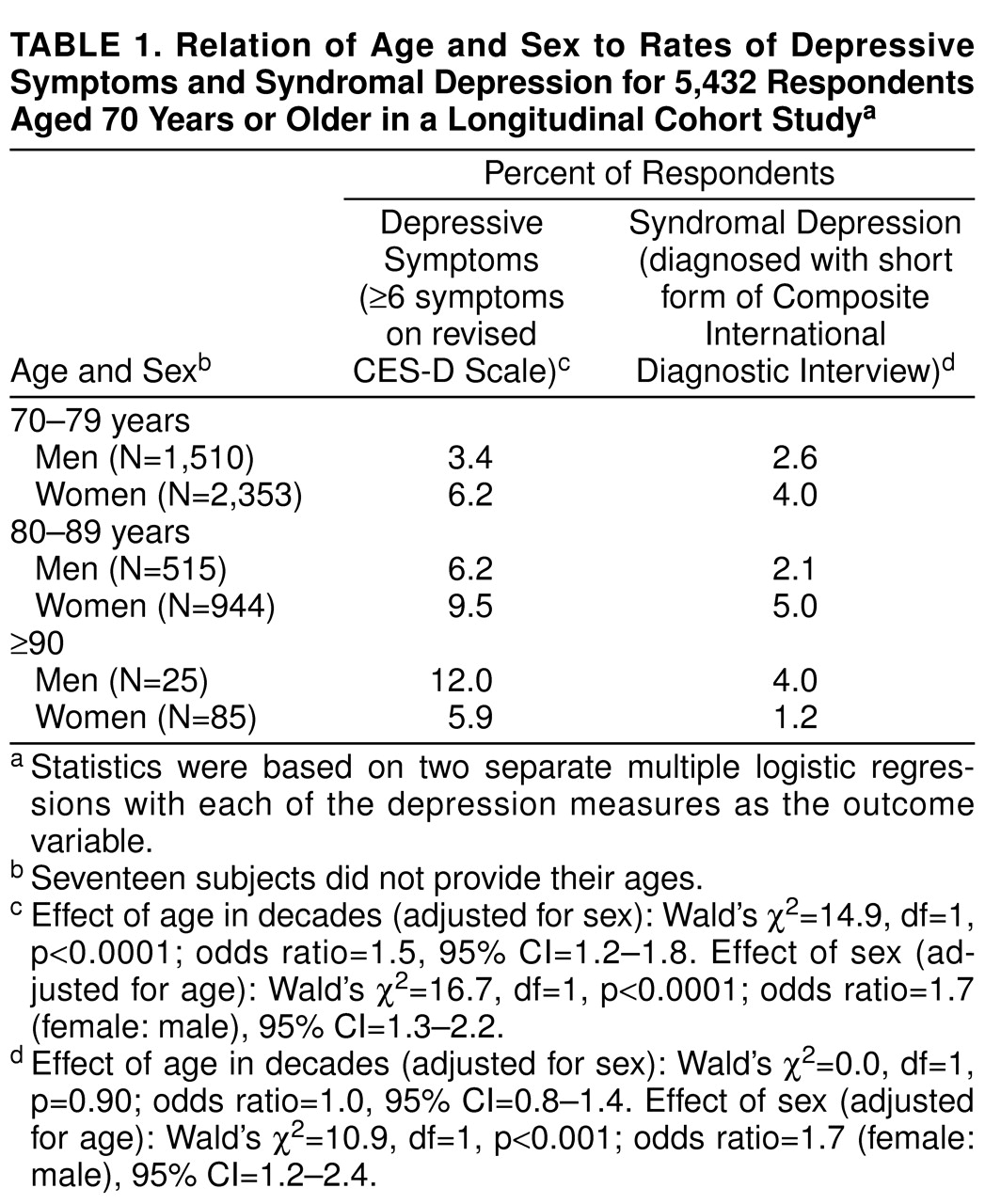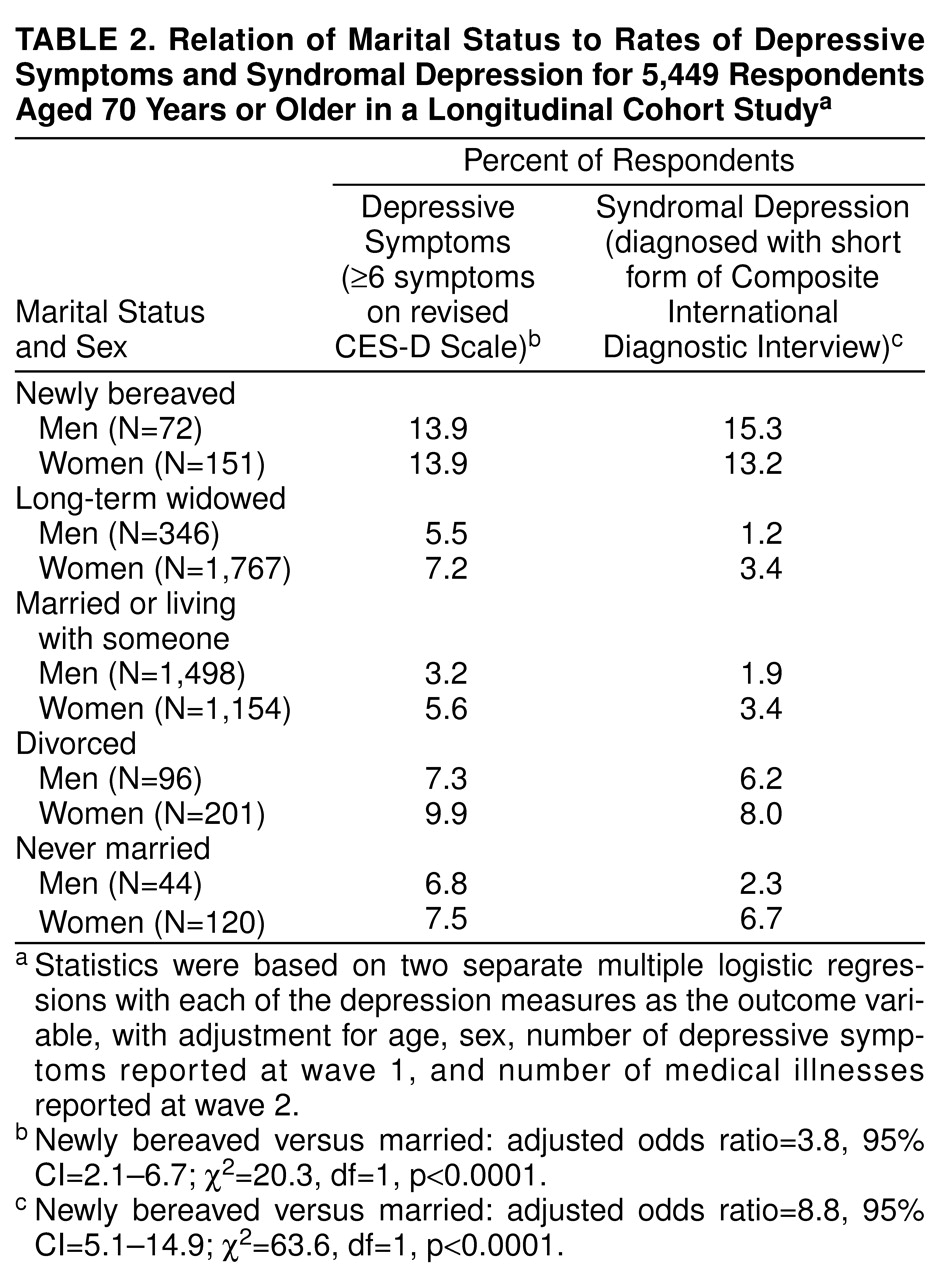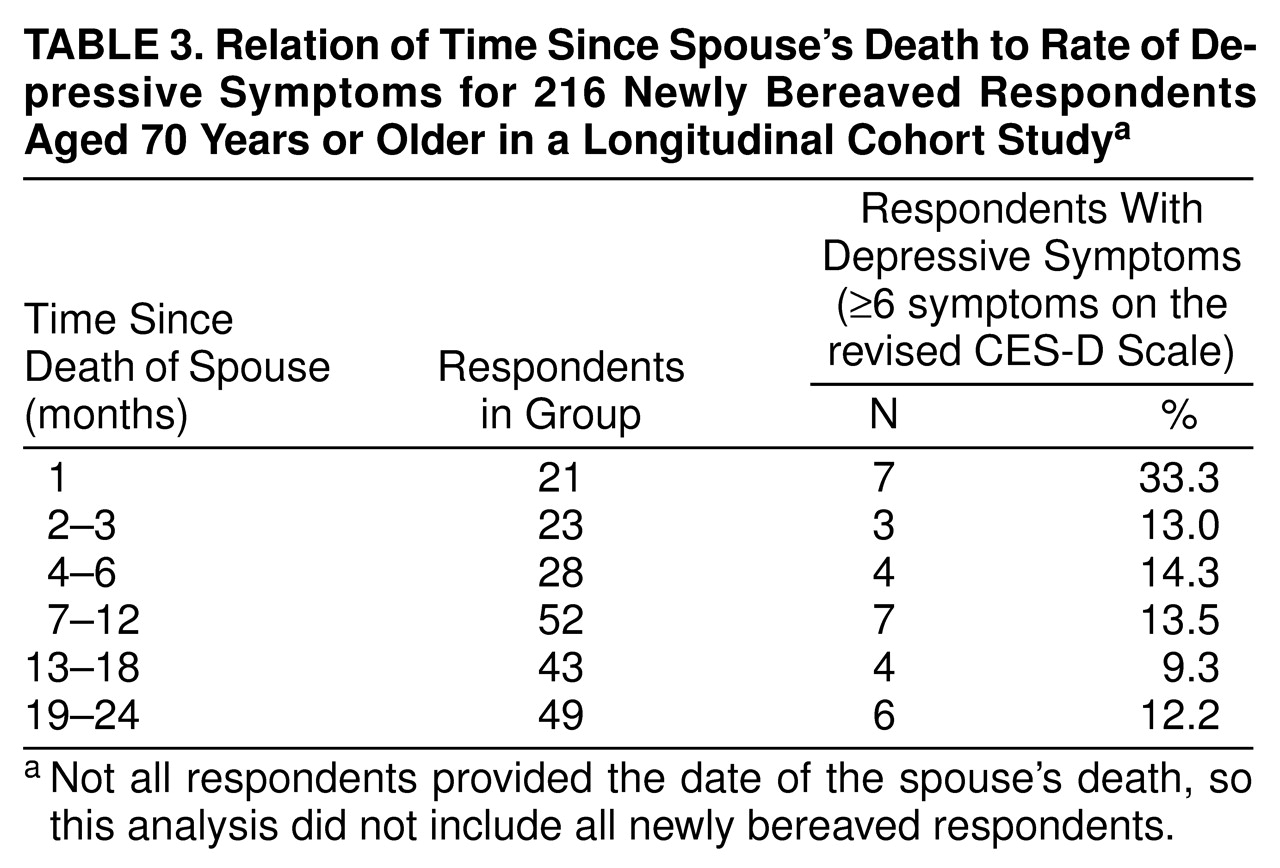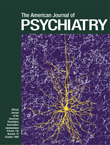As the population ages, it is increasingly important to understand the unique features of depression in the elderly. Physiologic changes, medical illness, and cognitive impairment associated with aging can alter the course or recommended treatment for depression
(1–
3). Since bereavement is more common in the elderly, an understanding of bereavement-related depression will provide information about a potential source of affective morbidity for this population.
In this study we examined conjugal loss in elders aged 70 years or older by using data collected as part of the study of Asset and Health Dynamics Among the Oldest Old
(4). This project is a biennial prospective panel study sampling the noninstitutionalized U.S. population born in 1923 or earlier and their spouses or partners. This survey included depression measures as part of the overall health assessment and therefore can be used to examine the association between bereavement and depression in the elderly.
To date, the Epidemiologic Catchment Area (ECA) study is the largest population-based study of bereavement-related depression
(5). Its data indicated low rates of bereavement-related depression in both men and women aged 65 years or older. In fact, at two of the three sites the rates of bereavement for men of this age group were lower than the rates for men in lower age groups, even though the younger men were less likely to have lost spouses. This finding, combined with similar findings from some of the earlier, smaller studies of bereavement, brought into question the seriousness of bereavement-related distress for the elderly
(2,
6,
7).
The ECA data contradict findings from smaller studies that do document high rates of depressive symptoms and depressive episodes in the elderly after loss of a spouse
(8–
15). The ECA study also showed low rates of depression overall in the elderly, which led Tweed et al.
(16) to argue that the elderly experience depression in a low-level symptomatic form that does not necessarily correspond to the DSM-IV criteria for syndromal depression. Therefore, the impact of conjugal loss in the elderly on measures of depressive
symptoms may be more evident than the effect on measures of depressive
episodes.
DSM-IV makes the distinction between normal and “complicated” bereavement. Complicated bereavement is defined as a grief response that persists beyond 2 months after the loss or that impairs functioning in a number of areas. The natural time course of bereavement is difficult to define. Two months may be rather brief given that bereavement in late life often occurs in marriages that have lasted 30 to 40 years. Persistent depression after death of a spouse has been documented in many studies, yet the younger bereaved have consistently shown poorer adjustment than older bereaved persons
(10,
17). Therefore, it is unclear whether the poor adjustment documented in these studies is accounted for primarily by the younger participants.
Studies of bereavement have examined potential risk factors for bereavement-related depression, but many of them have included younger bereaved subjects
(8,
11,
13,
17). It is unclear how many of the documented risk factors for bereavement, such as expectedness of death, bear on the elderly bereaved specifically. The context of spousal loss differs between older and younger people because many of the core tasks of couples, such as child rearing and home building, have been completed by older bereaved persons. Therefore, it is important to determine the personal and situational variables associated with bereavement-related depression that are unique to the elderly.
In this study we determined the impact of conjugal loss in a prospective cohort study of elderly subjects aged 70 years or older by addressing the following questions: Are older people at risk for episodes of syndromal depression and depressive symptoms after spousal loss? Are the elderly at risk for high rates of depressive symptoms long after the loss? Are there demographic or situational variables associated with bereavement-related depression, such as age, sex, prior psychiatric treatment, the expectedness of the loss, and whether the deceased was in pain?
METHOD
Sample
Asset and Health Dynamics Among the Oldest Old
(4) is a companion study to the Health and Retirement Study
(18) and is an investigation of the impact of health transitions on personal financial management, service and public program utilization, and intergenerational transfer of assets. The two sampling frames for the study were the 1992 screening of housing units enumerated for the Health and Retirement Study and the Health Care Financing Administration’s master enrollment file of Medicare enrollees who were living in households. The primary respondents had to be 70 years or older, and if the respondent was married, the respondent’s partner had to participate regardless of the partner’s age. Although the initial sampling frame excluded institutionalized elders, respondents who were institutionalized after wave 1 remained in the study and were interviewed at wave 2.
The first wave occurred in 1993–1994, and the second wave was in 1995–1996. Wave 1 included 8,406 respondents. Of these, 828 died between wave 1 and wave 2, for whom 775 family members or close acquaintances completed interviews describing the circumstances of the respondent’s death. Of the 7,578 living at wave 2, 7,038 completed the second interview, yielding a 93% follow-up rate. Depression measures were not administered to the respondents who received proxy interviews at wave 2 because of refusal or inability to complete the interview (N=901), and 10 subjects did not provide adequate information. Since this study focused on bereavement in people aged 70 years or older specifically, spouses younger than 70 years (N=678) were excluded. This thereby limited the sample size for analyses involving depression to 5,449. This study group was 86% Caucasian, 12% African American, and 2% Native American, Asian, or Pacific Islander. The mean age was 77 years (range=70–103 years), and 38% of the study group were male. Seventy-one percent of the participants had at least a high school education.
The data used in this study are from the data set of the Asset and Health Dynamics Among the Oldest Old study, which is preliminary and intended for public release by late 1999. All respondents provided oral informed consent, and internal ethics review board approval was obtained.
Outcome Variables
Syndromal depression and depressive symptoms were assessed at wave 2. Respondents aged 70 to 79 years were interviewed by telephone, and respondents 80 years or older were interviewed in person. The interviewers underwent a week-long training session conducted at the University of Michigan Survey Research Center. The interviewers conducted several trial interviews and received extensive feedback before being authorized to conduct interviews in the field. All interviews performed in the field were reviewed by an interview supervisor.
Psychiatric Measures
Syndromal depression was assessed by using a short form of the Composite International Diagnostic Interview (CIDI), a structured interview originally developed by the World Health Organization
(19) that was subsequently adapted for the National Comorbidity Survey
(20). This measure was used only in the second wave of the study. The short-form CIDI consists of the symptoms that best predicted caseness according to the full University of Michigan version of the CIDI, as determined by logistic regression (unpublished data of R. Kessler and D. Mroczek). It assesses eight of the nine possible associated symptoms required for diagnosis of a depressive episode by both DSM-III-R and DSM-IV criteria. The only symptom excluded was motor slowing or agitation.
The short-form CIDI does not exclude the diagnosis in the context of bereavement or organic causes. Therefore, concurrent medical illness was controlled for in the determination of risk of depression after conjugal loss. The combination of at least five symptoms, including depressed mood or anhedonia, and a 2-week duration was the threshold required for diagnosis. In a prior validation study, a five-symptom threshold on the short-form CIDI corresponded to a positive predictive value of 0.89 for diagnosis on the full-scale CIDI (unpublished data of R. Kessler and D. Mroczek) for respondents in the National Comorbidity Survey. The respondents in this study reported whether they had had an episode of depression at any time in the year before the interview.
The revised Center for Epidemiologic Studies Depression Scale (CES-D Scale) was administered in both wave 1 and wave 2. It is an eight-item version of the original scale
(21). A briefer version of the CES-D Scale was needed because pretests in Established Populations for Epidemiological Studies of the Elderly revealed that the full version was taxing, particularly when administered over the telephone
(22). A prior analysis of the data showed that the revised CES-D Scale has adequate internal consistency (Cronbach’s alpha, r=0.78) and a factor structure and distribution comparable to those of the larger full-version scale
(23). The revised CES-D Scale contains a simple yes/no format for each question. Each subject was asked to endorse the item if he or she had experienced the symptom “much of the time during the past week.” A six-symptom threshold was used to designate cases.
The revised CES-D Scale and the short-form CIDI both assess symptoms of depression. As such, the measures basically assess the occurrence of intense and pervasive dysphoria. The short-form CIDI more closely resembles a clinical diagnosis based on the DSM system because it has similar constraints regarding core symptoms, associated symptoms, and minimum duration. The revised CES-D Scale is a symptom checklist that models depression as an extreme on the continuous dimension of depressed mood. For this reason, depression as assessed by the short-form CIDI is referred to as “syndromal depression” and depression as assessed by the revised CES-D Scale is referred to as “depressive symptoms.”
Explanatory Variables
Marital status
The participants were divided into five groups on the basis of marital status, assessed at wave 2. The newly bereaved (N=223) had lost a spouse or live-in significant other at some point between the wave 1 and wave 2 interviews. The long-term widowed group (N=2,113) consisted of respondents who were widowed at wave 2 but had lost their spouses or live-in partners before the wave 1 interview. Subjects who were married or living with someone (N=2,652), divorced (N=297), or never married (N=164) constituted the three remaining groups.
Health measures
At both wave 1 and wave 2, each participant reported whether a medical doctor had diagnosed cancer, diabetes, high blood pressure, lung disease, heart problems, stroke, or arthritis. The respondent also reported whether he or she had sought psychiatric treatment at any time in his or her life.
Nature of spouse or partner’s death
A proxy interview about each deceased respondent was conducted with a spouse, relative, or knowledgeable acquaintance. The proxy interviewee indicated whether the death was expected, whether the deceased was in pain at the time of death, and the proxy interviewee’s subjective belief about whether the deceased was depressed before the death.
Statistical Analysis
Odds ratios were derived from multiple logistic regressions to determine the association of the two depression measures to age and sex. We conducted an additional set of logistic regression analyses in which depression was the outcome variable and a dummy variable contrasting the newly bereaved to the married was the explanatory variable; these analyses were adjusted for age, sex, preloss depressive symptoms according to the wave 1 CES-D Scale score, and the total number of medical illnesses reported at wave 2. The short-form CIDI was not administered at wave 1, so there could be no control for baseline syndromal depression, only baseline depressive symptoms. The remaining analyses used chi-square statistics for categorical variables and Student’s t tests for continuous variables. The results of the analyses of risk factors for bereavement-related depression, such as lifetime psychiatric history or expectedness of death, were comparable for the short-form CIDI and the revised CES-D Scale, so only the results for the former are presented. In order to adjust significance levels for multiple comparisons, only p values less than 0.01 were considered significant.
RESULTS
Rates of Syndromal Depression and Depressive Symptoms
The rates of syndromal depression and depressive symptoms are provided in
Table 1. Older subjects and women had higher rates of depressive symptoms, i.e., six or more symptoms on the revised CES-D Scale. Subjects with syndromal depression were also more likely to be women. Syndromal depression was not significantly associated with age.
As seen in
Table 2, newly bereaved individuals had the highest rates of syndromal depression and depressive symptoms. In a multivariate analysis, the newly bereaved were at higher risk for syndromal depression, as diagnosed with the short-form CIDI, than were the married respondents; this persisted even after we controlled for age, sex, number of preloss depressive symptoms reported at wave 1, and number of medical illnesses in the newly bereaved reported at wave 2. Similarly, the newly bereaved sample had a higher rate of depressive symptoms, as assessed with the revised CES-D Scale, after adjustment for the same variables. Notably, the long-term widowed sample had rates of depression comparable to those of the married sample.
Depressive Symptoms and Time Since Death of Spouse
The newly bereaved sample was divided into six groups on the basis of the amount of time elapsed since the death of the spouse or partner. The percentage of respondents who were above the six-symptom threshold on the revised CES-D Scale was calculated for each group, and these percentages are presented in
Table 3. The rates for the short-form CIDI are not presented because the time between the death of the spouse and the end of the depressive episode could not be determined.
The percentage of the bereaved sample who scored above the threshold on the revised CES-D Scale was quite high for those interviewed 1 month after the death of the spouse (
Table 3). The proportion appears to decrease substantially by 2–3 months and stabilizes at about 12%. The rate was still high for the group interviewed 2 years after the loss of a spouse. Depressive symptoms above the threshold level were experienced by 12.2% of this group, which is higher than the 4.0% reported by the married respondents (Fisher’s exact test, p=0.03), although not at the predetermined level of significance for this study.
Risk Factors for Bereavement-Related Depression
There was no significant difference between the newly bereaved respondents who were and were not diagnosed as depressed according to the short-form CIDI in gender distribution (depressed, 32% male; nondepressed, 35% male) (χ2=0.2, df=1, p=0.70) or in age (depressed, mean=80 years, SD=4.8; nondepressed, mean=80 years, SD=5.0) (t test with equal variance, t=–0.6, df=221, p=0.55). Nor did the depressed widows and widowers report significantly higher rates of lifetime psychiatric treatment (depressed, 10%; nondepressed, 9%) (χ2=0.01, df=1, p=0.90). The bereaved subjects who were depressed were actually less likely to report that the death of the spouse was unexpected (depressed, 33%; nondepressed, 44%) (χ2=1.3, df=1, p=0.26), but they were more likely to report that the spouse was in pain at the time of death (depressed, 65%; nondepressed, 47%) (χ2=3.2, df=1, p=0.07) and that the spouse was depressed at the time of death (depressed, 61%; nondepressed, 41%) (χ2=4.3, df=1, p=0.04), although none of these differences reached the predetermined level of statistical significance.
DISCUSSION
This study provides evidence from a large, prospective, population-based cohort study that there is a strong association between bereavement and depression for both men and women aged 70 years or older. Newly bereaved respondents had a risk for syndromal depression nearly nine times that of their married counterparts even after we controlled for age, sex, preloss depressive symptoms, and medical illness.
The elderly are also at risk for extended periods of high symptom levels after conjugal loss, as indicated by the 12.2% of the newly bereaved who scored above the threshold on the revised CES-D Scale when interviewed 24 months after their spouses’ death. This proportion is comparable to the 16.7% found by Mendes de Leon et al.
(8), who followed bereaved subjects longitudinally over time. The clinical presentation of chronic low-level depressive symptoms often seen in the elderly
(3,
16) may be due to unresolved grief.
The lower rates of depression for the long-term widowed group suggest that most elderly widows do eventually adjust. Therefore, one may be generally optimistic about a good outcome for depressive symptoms after spousal loss. However, for a subgroup of newly bereaved this will take longer than the 2 months designated in DSM-IV. Given that, in most cases, widows and widowers in late life are losing their lifetime companions, an extended period of adjustment may be expected.
None of the risk factors for bereavement-related depressive symptoms assessed in this study was significant. The direction of the findings suggests that such loss is harder for a person whose spouse dies a painful death that is expected, possibly due to protracted illness. However, this idea must remain speculative given that none of the findings was strong enough to reach statistical significance.
This study has some methodological limitations that must be kept in mind in the interpretation of results. The measures of depression in this study cannot be seen as a substitute for a full diagnostic evaluation administered in a clinic setting where functional impairment and clinical significance are incorporated into the diagnosis. As with any large-scale community study, the quality of assessment was limited by the logistic demands of assessing more than 5,000 individuals sampled from the entire United States.
The measures of depression in this study are best conceptualized as indicators of the presence and severity of depressive symptoms. However, two studies have documented a strong association between depressive symptoms, even at the subsyndromal level, and functional impairment
(24,
25). Furthermore, people who report depressive symptoms often go on to have full-blown major depressive episodes
(26), and people who experience periods of minor depression are more similar to depressed individuals than to individuals who report no depressive symptoms
(27). Therefore, it is likely that the widows and widowers who were designated as depressed by the measures in this study are suffering substantial depressive morbidity that puts them at risk for clinical depression and functional impairment.
The respondents were asked if they had experienced any depressive episodes in the year before the interview. However, the bereaved sample was defined as respondents who had lost spouses or partners at any time since the wave 1 interview, a period of approximately 2 years. Therefore, the spouse may have experienced depression before the time frame assessed in this study. However, if this were the case, it would mean that the association between bereavement and depression was underestimated, not overestimated.
The short-form CIDI has yet to be validated in people over age 55. This instrument is comparable to the structured interview used in the ECA study and the National Comorbidity Survey. Although the lack of rule-out criteria for organic illness is important, it is uncertain how it could cause a spurious association between marital status and syndromal depression.
Future research and interventions should target the subgroup of widows and widowers who do not adjust to their spouses’ deaths. Several investigators are delineating the key clinical features of complicated bereavement
(28,
29). Such research can extend this study by characterizing the widows and widowers who show prolonged depressive symptoms and the characteristics of those who cope well and continue to lead satisfying lives even though they have suffered a considerable loss.




